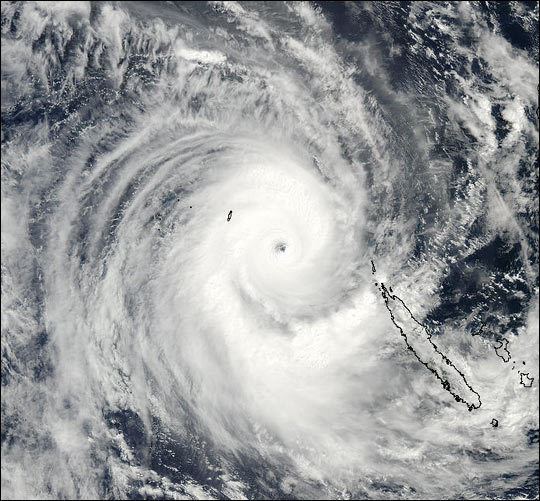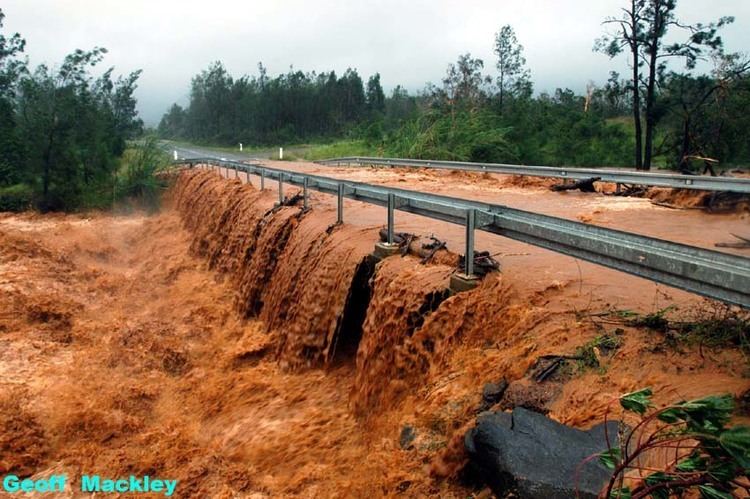Formed 1 March 2003 Fatalities 2 total | Dissipated 15 March 2003 Damage $15 million (2003 USD) | |
 | ||
Highest winds 10-minute sustained: 215 km/h (135 mph)1-minute sustained: 240 km/h (150 mph) Lowest pressure 915 hPa (mbar); 27.02 inHg Date 1 March 2003 – 15 March 2003 Similar Cyclone Inigo, Cyclone Gwenda, Cyclone Fay, Cyclone Kathy, Cyclone Magda | ||
Cyclone erica hits new caledonia part 1 of 2
Severe Tropical Cyclone Erica (RSMC Nadi designation: 10F, JTWC designation: 23P) of March 2003 was a powerful cyclone that severely affected New Caledonia and was considered the worst to affect the country since Cyclone Beti. The system was the eighth cyclone and the fifth severe tropical cyclone of the 2002-03 South Pacific cyclone season. Cyclone Erica developed from a monsoonal trough on 4 March just off of Queensland. Originally, the storm moved slowly towards the east and then north early in its existence. However, increasing wind shear caused the storm to be degenerated into a tropical low. After conditions once again became more favorable for development, the remnants regenerated into a tropical cyclone on 10 March. Steadily intensifying, Erica reached peak intensity on 13 March as a Category 5 equivalent on the Saffir–Simpson Hurricane Scale.
Contents
- Cyclone erica hits new caledonia part 1 of 2
- Cyclone erica hits new caledonia part 2 of 2
- Meteorological history
- Australia
- New Caledonia
- References
On the same day Erica paralleled the coast of New Caledonia before making landfall on the southern end of the island at L'Île-des-Pins. However, at the same time the cyclone also entered an area with strong wind shear and thus began to weaken. After passing the island, an extratropical transition begun, weakening the cyclone as it moved towards the southeast. On 15 March, Erica completed its transition into an extratropical cyclone and later fully dissipated the next day.

Cyclone Erica severely impacted the island nation of New Caledonia, causing intense winds and heavy rain. An estimated 892 families were affected by the cyclone on the island, and two people were killed. As many as 60% of people on the west coast lost power. On 17 March only 17 of the 66 secondary schools on the island were functioning. After the storm it was feared that the existing dengue fever epidemic on the island would spread. Erica caused $15 million (2003 USD) in damages, primarily on New Caledonia. Following the deaths and damage, the name "Erica" was later retired.

Cyclone erica hits new caledonia part 2 of 2
Meteorological history

The origins of Cyclone Erica can be traced back to a tropical low which developed within a monsoonal trough near the Tiwi Islands on 13 February. Two days later, the low moved inland near the Western Australia–Northern Territory border. After passing south of Alice Springs, the low turned east and entered the Coral Sea on 3 March 2003. Strong wind shear separated the convection from the system at the time. However, shear quickly weakened the next day. With the lower shear, the low was able to intensify and at 0630 UTC on 4 March, the Joint Typhoon Warning Center (JTWC) issued a tropical cyclone formation alert. Despite the center of the storm being elongated, conditions for further development were present. At 0600 UTC the Bureau of Meteorology in Australia upgraded the low to a Category 1 cyclone and gave it the name Erica.
As Erica moved towards the south and subsequently to the north, the cyclone strengthened, becoming equivalent to a tropical storm according to the JTWC by 1500 UTC on 5 March. Erica later attained maximum sustained winds of 105 km/h (65 mph 1-minute sustained). However the system began to move against the direction of the wind shear environment, and it lost much of its organization. On 7 March at 2230 UTC, Erica lost cyclone status and degenerated into a tropical low. The remnant circulation moved slowly to the northeast, and the wind shear conditions abated. As a result, Erica began to gain some signs of organization. At this time the remnants moved towards the southeast as a result of an upper–level trough developing over Australia.
The area of low pressure gained sufficient shower activity and organization to be renamed as a tropical cyclone at 1800 UTC on 10 March while located southwest of the Solomon Islands capital of Honiara. Erica gradually intensified, attaining the equivalent to a Category 1 hurricane on the Saffir–Simpson Hurricane Scale (SSHS) Originally moving to the southeast at a slow pace, Erica began to accelerate due to the influence of weak mid–level ridge to its east. Continuing to intensify, the cyclone reached its peak intensity on 13 March with a minimum barometric pressure of 915 mbar (27.0 inHg), and peak winds of 260 km/h (150 mph 1-minute sustained). The eye of the cyclone began to shrink in diameter and become symmetrical. Later on 13 March, Erica began to parallel the western coast of New Caledonia while maintaining a strong intensity, before crossing the extreme southern end of the island at the Caledonian island commune of L'Île-des-Pins.
After passing the island, Erica accelerated and began to rapidly weaken in the presence of strong wind shear. As a result, the cyclone began a phase of extratropical transition as it quickly paced to the southeast. On 15 March, Erica completed this transition. The remnant low continued to the east–southeast, before the Meteorological Service of New Zealand Limited office at Wellington, New Zealand (TCWC Wellington) issued their last advisory on Erica at 1800 UTC on 16 March.
Australia
As a tropical low, Erica brought strong winds to northern Queensland. Several large trees were uprooted, one of which fell on a car in Cape Tribulation and another on a house in Port Douglas. Numerous trees were defoliated and some boats were reported to have been pulling their moorings due to the wind. Power lines were also damaged by the low.
New Caledonia
On 12 March, officials in New Caledonia issued a pre-alert as Erica was forecast to impact the territory. Evacuation centers were set up in churches and community halls. All schools throughout the island were closed and airports were shut down.
Despite the rapid weakening before landfall, Erica produced intense winds, gusting to a record 202 km/h (125 mph) in Nouméa. Ten-minute sustained winds were recorded up to 144 km/h (89 mph) around the center of the storm.
An estimated 892 families were affected by Erica, and Erica was also reported to have caused two deaths and injured 80 people. In addition 1,000 people were estimated to be homeless. Several communication lines were severed, and tribes and farms were devastated. 20% of electricity customers in Nouméa were without power, and 60% of customers on the main island's west coast were also without power. In Yaté, police assessed that half of the population was without shelter, and in Pohé, it was estimated that 90% of the crops were destroyed by Erica. On 17 March 2003, only 17 of the 66 secondary schools in New Caledonia were functioning, with others still closed primarily due to safety concerns. The University of New Caledonia was also badly damaged. However, all primary schools were functioning.
South Province, New Caledonia formed an emergency committee following the storm, led by Jacques Lafleur. The committee assisted in filing damage claims caused by the cyclone. After the storm, 60 French specialists were sent to New Caledonia to help in rebuilding areas hit hard by Erica. Ministry of Overseas France head Brigitte Giradin arrived in Nouméa on 17 March to investigate the damage. Following the visit, Brigitte Giradin announced that US$17 million would be sent to rebuild 1,000 homes on the island nation, including an additional US$500,000 in disaster relief to the island country. A transport aircraft stationed in Tahiti brought 1.5 short tons (1,400 kg) of emergency supplies.
Following Erica's heavy rains, it was feared that the already existing dengue fever epidemic would become more widespread. Prior to Erica, there were already 437 cases of dengue fever in 2003 alone. The risk for leptospirosis was also increased by Erica. High winds and strong rains resulted in damages of at least US$15 million, particularly to schools. Two fatalities total were reported as a result of Erica. The name Erica was retired after the season.
